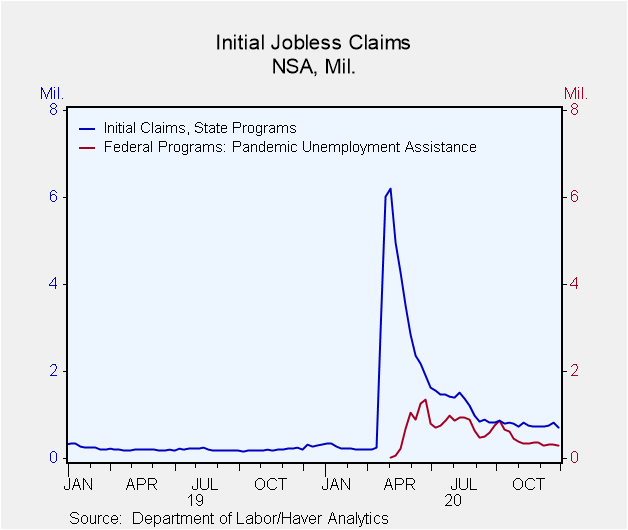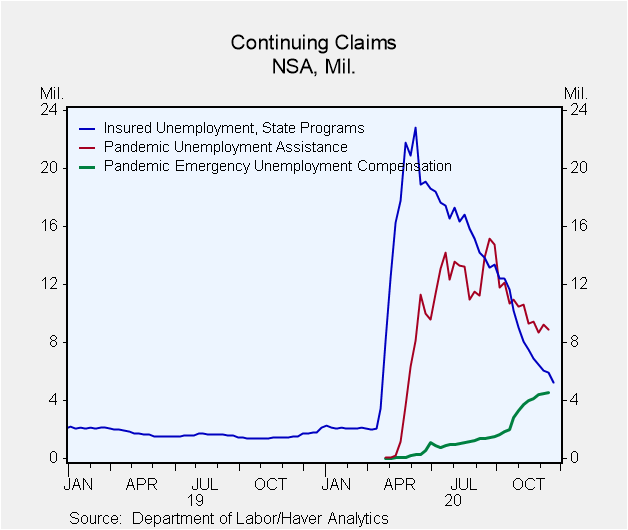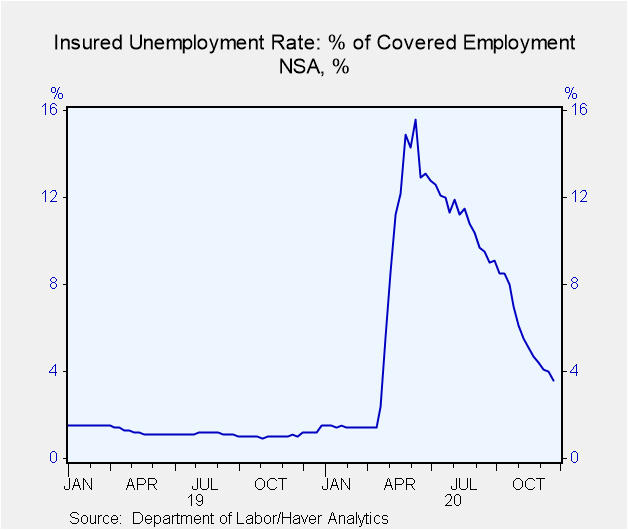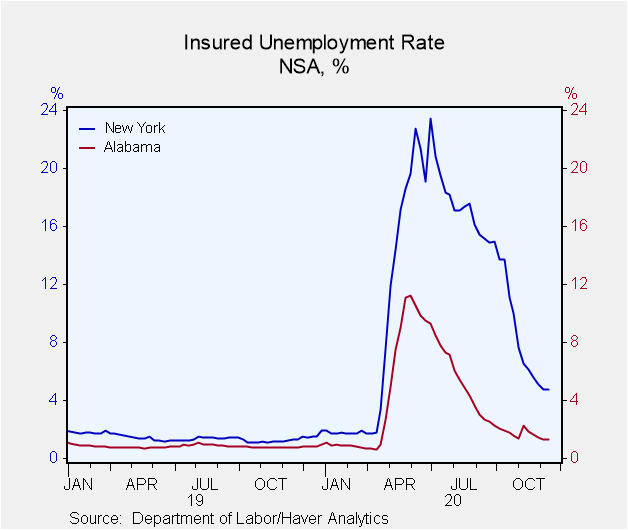 Global| Dec 03 2020
Global| Dec 03 2020U.S. Initial Unemployment Insurance Claims Fall Sharply
by:Tom Moeller
|in:Economy in Brief
Summary
• State initial claims at lowest level in three weeks. • Continuing claims fall to lowest level since late-March. • Pandemic unemployment assistance remains down from earlier highs. • Insured unemployment rate continues downtrend. [...]
• State initial claims at lowest level in three weeks.
• Continuing claims fall to lowest level since late-March.
• Pandemic unemployment assistance remains down from earlier highs.
• Insured unemployment rate continues downtrend.
Initial claims for regular state unemployment insurance declined sharply during the week ended November 28 to 712,000 (+246% y/y) from 787,000 during the prior week, revised from 778,000. The Action Economics Forecast Survey expected 768,000 initial claims. Haver Analytics has calculated methodologically-consistent seasonally adjusted data which matches the Department of Labor seasonally adjusted data since the late-August break.
Initial claims for the federal Pandemic Unemployment Assistance (PUA) program, which covers individuals such as the self-employed who are not included in regular state unemployment insurance, declined 9.5% in the week ended November 28 to 288,701, the lowest level since the third week of April. Data for this program date back only to April 4 and initial processing backlogs make comparisons to the early figures challenging. Numbers for this and other federal programs are not seasonally adjusted.
Continuing claims for regular state unemployment insurance programs fell to 5.520 million (+225% y/y) in the week ended November 21 from 6.089 million the prior week. Haver Analytics methodologically consistent seasonally adjusted continuing claims showed the same readings for those weeks. Not seasonally adjusted continuing claims dropped to 5.241 million. Both seasonally adjusted and not seasonally adjusted series were the lowest since the week of March 21.
Continuing PUA claims, which are lagged an additional week and not seasonally adjusted, fell in the November 14 week, to 8.870 million from 9.209 million the prior week. Pandemic Emergency Unemployment Compensation (PEUC) claims rose slightly to a new high of 4.569 million in the week ending November 14. This program covers people who were unemployed before COVID but exhausted their state benefits and are now eligible to receive an additional 13 weeks of unemployment insurance, up to a total of 39 weeks.
The seasonally adjusted insured unemployment rate fell to 3.8% in the week ending November 21 from 4.2%. These data do not include the federal pandemic assistance programs. If you include the latest data available, which are lagged one additional week, the total number of state, PUA and PEUC continuing claims rose to 20.163 million or 12.5% of the labor force.
The state insured rates of unemployment -- which do not include the special federal programs -- continued to show wide variation. In the week of November 21, the states with the lowest rates include South Dakota (0.9%), Utah (1.0%), Idaho (1.2%), Nebraska (1.2%) and Alabama (1.3%). The highest rates were in California (7.3%), Hawaii (7.1%), Nevada (6.7%), Alaska (6.4%) and Massachusetts (6.0%). Other large-population states include New York (4.8%), Pennsylvania (5.3%) and Texas (3.7%). These state rates are not seasonally adjusted.
Data on weekly unemployment claims going back to 1967 are contained in Haver's WEEKLY database, and they are summarized monthly in USECON. Data for individual states are in REGIONW. The expectations figure is from the Action Economics Forecast Survey, carried in the AS1REPNA database.
| Unemployment Insurance (SA, 000s) | 11/28/20 | 11/21/20 | 11/14/20 | Y/Y % | 2019 | 2018 | 2017 |
|---|---|---|---|---|---|---|---|
| Initial Claims | 712 | 787 | 748 | 246 | 218 | 221 | 244 |
| Initial Claims (NSA) | 714 | 836 | 749 | 229 | 218 | 221 | 243 |
| Initial Claims Pandemic Unemployment Assistance (NSA) | 289 | 319 | 324 | -- | -- | -- | -- |
| Continuing Claims | -- | 5,520 | 6,089 | 225 | 1,701 | 1,756 | 1,961 |
| Continuing Claims (NSA) | -- | 5,241 | 5,931 | 248 | 1,704 | 1,763 | 1,964 |
| Continuing Claims Pandemic Unemployment Assistance (SA) | -- | -- | 8,870 | -- | -- | -- | -- |
| Insured Unemployment Rate (%) | -- | 3.8 | 4.2 |
1.2 |
1.2 | 1.2 | 1.4 |
Tom Moeller
AuthorMore in Author Profile »Prior to joining Haver Analytics in 2000, Mr. Moeller worked as the Economist at Chancellor Capital Management from 1985 to 1999. There, he developed comprehensive economic forecasts and interpreted economic data for equity and fixed income portfolio managers. Also at Chancellor, Mr. Moeller worked as an equity analyst and was responsible for researching and rating companies in the economically sensitive automobile and housing industries for investment in Chancellor’s equity portfolio. Prior to joining Chancellor, Mr. Moeller was an Economist at Citibank from 1979 to 1984. He also analyzed pricing behavior in the metals industry for the Council on Wage and Price Stability in Washington, D.C. In 1999, Mr. Moeller received the award for most accurate forecast from the Forecasters' Club of New York. From 1990 to 1992 he was President of the New York Association for Business Economists. Mr. Moeller earned an M.B.A. in Finance from Fordham University, where he graduated in 1987. He holds a Bachelor of Arts in Economics from George Washington University.










